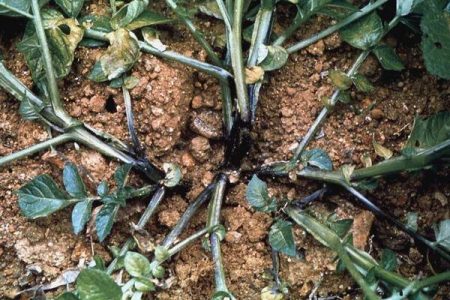
Many gardeners know what a black leg on a potato represents, but not everyone knows how to deal with it. The disease itself is dangerous for the crop. If you leave the crop unprocessed, do not take any measures to save the tubers, you can lose half the crop.
The causative agents of the disease are three types of one bacterium. Each type of bacteria has its own characteristics, and the ability to withstand various weather conditions. Any variety of culture can be affected, but some have better immunity to the black leg of potatoes; nevertheless, all gardeners who value work and harvest need to know the control measures.
Content
Description of the symptoms of black legs on potatoes
Bacteria of a pathogenic type may not give obvious symptoms of the disease for a long time, but the plant will suffer from a black leg. The disease is common, found on tomatoes and eggplant. This is a common occurrence for cabbage, radish, pepper.
It is not in vain that many potato growers' manuals recommend carefully inspecting the planted crop in order to detect the first alarming calls in time.
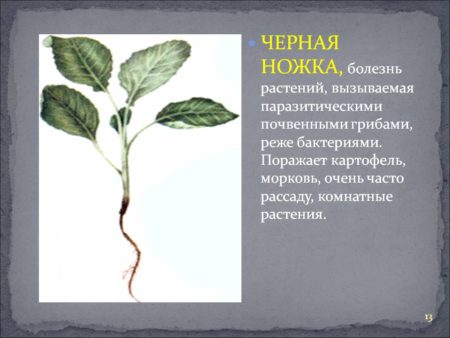
Potato tubers are more affected, but the aerial part also shows symptoms:
- Brown spots appear on the stems.
- The leaves are curled, which begin to turn yellow and dry.
- Shoots often become dark, sometimes black and soft with hints of spreading mucus. The mucus coming on the shoots has a green tint.
At the initial stage of infection, pathogens multiply and attack plants, starting from the stem. From the stem part they confidently go to the roots, and tend to hit the tubers faster. An infected tuber will have brown spots that become larger and darker over time. Tubers can rot and blacken, depending on the degree of infection and the activity of microorganisms from a few days to weeks.
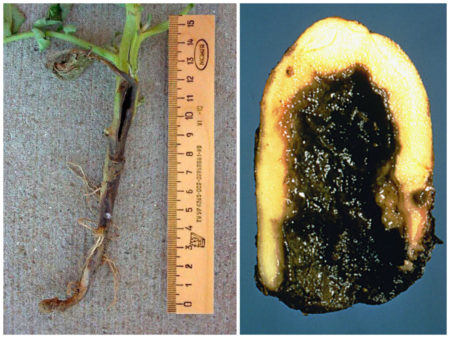
Causes of infection
If the potato stalks black, gardener this suggests the presence of the disease. But how many were interested in how the disease occurs, for what reasons. The ideal condition for the spread of pathogens is rain and dampness.
The cicada pest is capable of transmitting disease and viruses. The Colorado potato beetle is able to become another insect that carries the pathogens of the black leg; the number of carriers includes wireworm and aphids. The black leg of the potato destroys the tubers quickly, photos of the results of the "work" of pathogenic organisms can be seen on the network.Gardeners transporting fruits over long distances may not adhere to appropriate storage conditions, which, combined with insufficient use of fertilizer during potato cultivation, can cause a black leg.
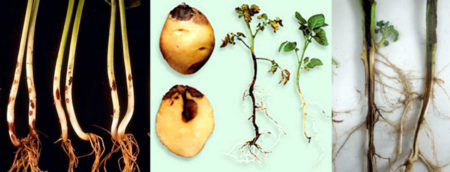
Potato Black Leg Biology
The potato is sick from the black leg rapidly, the stalk turns black and rot. All because of pectolytic enzymes, leading to wet rot and mucus. The bacterium secretes an enzyme that can lead to maceration. Damaged tissue culture allows the disease to spread, it is additionally carried by insects that often attack the culture. In heavy, moist soil, bacteria that provoke the black leg are the easiest to spread. The bacterium also feels good in sandy soil.

Black leg on potatoes how to fight
When the root of the potato turns black, gardeners grab their head in panic. But the disease can be overcome, and it is better to prevent it with the help of preventive measures. If you use healthy planting material, you can significantly minimize the risks of infection of potatoes with a terrible disease.
The quality of planting material is the key to crop quality:
- Planting a culture is necessary only in areas free of pathogens.
- If the soil was infected with black leg bacteria, then potatoes cannot be planted on it for at least three years, or even four.
- The gardener must turn to crop rotation.
Symptoms, infections can occur some time after the appearance of the first shoots. The plant is dug up, planting bushes repeatedly deep into the ground, using bleach to powder from above. Many gardeners recommend that they burn infected bushes immediately to reduce the chances of spreading the infection.
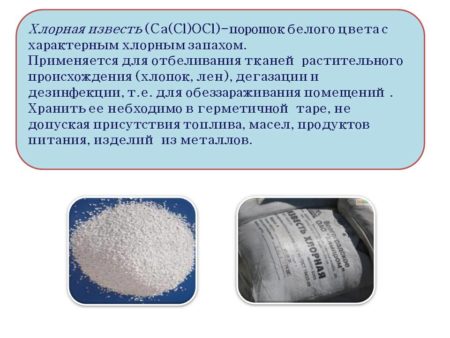
Potato stalks must be mowed and taken out of the garden before harvesting. Mowing is carried out seven days before proceeding with the collection of tubers. Organics left over from potatoes should be burned away from the site. So that the soil, in which there may be a microorganism that causes the black leg, does not stick to the dug up tubers, cleaning is carried out in dry weather.
Tubers must be dried before being stored. Many gardeners prefer planting potatoes before hiding it in a bookmark for the winter.
An effective method is the use of a chemical agent. You can pickle tubers with a tool called TMTD, VSK. 4 l of the product must be dissolved in 70 l of pure water. This is enough to process a ton of potatoes.
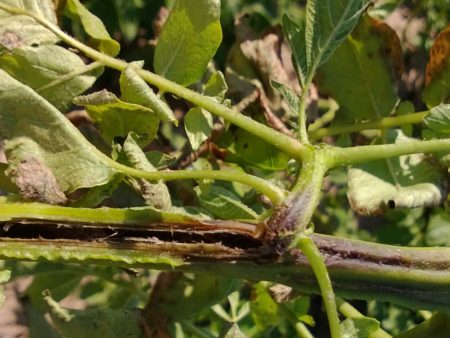
Reviews
Maksim:
“I have been growing potatoes for many years. I rarely encounter a black leg. I try to monitor the development of seedlings and prevent the spread of infection. You can’t hesitate so that microorganisms do not move to neighboring bushes. I know from my own experience that this can happen quickly. I don’t have the opportunity to go to the country, often check the potatoes, I try to constantly process the tubers with biological agents before planting. ”
Michael:
“I used TMTD for the last time to seed tubers before planting. The result was good. There are no problems with the harvest, we enjoyed good tubers, I didn’t even have to remove the infected bushes from the garden, they simply weren’t ”.
Anastasia:
“A neighbor complained about a black leg.I haven’t encountered her for three years now. I got used to carefully sorting tubers before planting. And during the excavation, it is better to immediately throw aside the suspicious fruits. If you plant green potatoes, often fertilize them and process them without fail, there will be no chance of spreading the pathogen of the black leg. ”
Igor:
“The black leg is a serious problem. I never thought that a disease could progress so quickly. One year lost about half of the crop. Since then, I have not planted tubers without pretreatment. ”
Alexandra:
“With confidence I can advise everyone Fitosporin-M, although there are many worthy alternatives on the market. But for processing from a black leg before landing, I always buy such a tool. The maximum performance, there is no reason to worry with proper care of the culture. "
Tamara:
“The black leg is an insidious disease, it can sneak up quickly and imperceptibly, but vigilant gardeners will always recognize the first signs of the disease and destroy the infected bushes. If you fertilize potatoes in time and take care of it, as it should, then this problem and other misfortunes will not be. Potatoes need attention. For reliability, you can use biological agents, I rarely do this. I prefer to choose varieties that have natural immunity from the black leg.




 Description and description of varieties in Belarus with a photo
Description and description of varieties in Belarus with a photo Do I need to pick flowers from potatoes: why do they do it
Do I need to pick flowers from potatoes: why do they do it When to dig potatoes: timing and availability of new potatoes
When to dig potatoes: timing and availability of new potatoes How to grow a good potato crop: various methods and methods, planting and care
How to grow a good potato crop: various methods and methods, planting and care